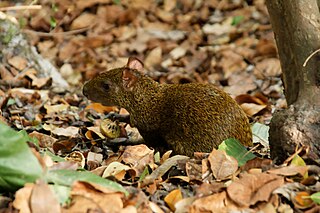
Dasyproctidae is a family of large South American rodents, comprising the agoutis and acouchis. Their fur is a reddish or dark colour above, with a paler underside. They are herbivorous, often feeding on ripe fruit that falls from trees. They live in burrows, and, like squirrels, will bury some of their food for later use.

The lowland paca, also known as the spotted paca, is a large rodent found in tropical and sub-tropical America, from east-central Mexico to northern Argentina, and has been introduced to Cuba and Algeria.

The agouti or common agouti is any of several rodent species of the genus Dasyprocta. They are native to Middle America, northern and central South America, and the southern Lesser Antilles. Some species have also been introduced elsewhere in the West Indies. They are related to guinea pigs and look quite similar, but they are larger and have longer legs. The species vary considerably in colour, being brown, reddish, dull orange, greyish, or blackish, but typically with lighter underparts. Their bodies are covered with coarse hair, which is raised when alarmed. They weigh 2.4–6 kg (5.3–13.2 lb) and are 40.5–76 cm (15.9–29.9 in) in length, with short, hairless tails.

The palm tree Phytelephas aequatorialis, commonly known as Ecuadorian ivory palm, is the main source of Ecuadorean vegetable ivory or tagua, a botanical alternative to ivory. It is found in the tropical rainforests of the western Andean slopes of Ecuador. It has a woody trunk which can grow to 20 m in height and very long pinnate leaves.

The black agouti, Dasyprocta fuliginosa, is a South American species of agouti from the family Dasyproctidae. It is found in the northwestern Amazon in southern Venezuela, eastern Colombia, eastern Ecuador, western Brazil and northeastern Peru. There is also a disjunct population in the Magdalena River Valley of northern Colombia. The black agouti weighs 3.5–6 kg (7.7–13.2 lb). It is overall black grizzled white, and the throat is white. Like other agoutis, the black agouti is diurnal, lives alone or in pairs, and feeds on fruits and nuts.

The red-rumped agouti, also known as the golden-rumped agouti, orange-rumped agouti or Brazilian agouti, is a species of agouti from the family Dasyproctidae.

Azara's agouti is a South American agouti species from the family Dasyproctidae. Found in Brazil, Paraguay, and Argentina, it is named after Spanish naturalist Félix de Azara. The population is unknown and may have gone locally extinct in some areas due to hunting; it is listed as vulnerable in Argentina.

The black-rumped agouti is an agouti species from the family Dasyproctidae. It is endemic to Brazil, and its range roughly equals the Northeast Region. It is named after its black rump which contrast clearly with the orange body.

The Central American agouti is a species of agouti from the family Dasyproctidae. The main portion of its range is from Chiapas and the Yucatan Peninsula, through Central America, to northwestern Ecuador, Colombia and far western Venezuela. A highly disjunct population is found in southeastern Peru, far southwestern Brazil, Bolivia, western Paraguay and far northwestern Argentina. The disjunct population has been treated as a separate species, the brown agouti, but a major review of the geographic variation is necessary. The Central American agouti has also been introduced to Cuba and the Cayman Islands.

Phytelephas seemannii, commonly called Panama ivory palm, is a species of flowering plant in the family Arecaceae. It is one of the plants used for vegetable ivory.
The crested agouti is a species of rodent in the family Dasyproctidae. It is endemic to Guyana and Suriname. Its taxonomic status is uncertain and it may be synonymous with Dasyprocta leporina, leading the IUCN to rate it as Data Deficient.
The Orinoco agouti is a species of rodent in the family Dasyproctidae. It is endemic to Delta Amacuro in Venezuela, where found in areas with rainforest or mangrove.
Kalinowski's agouti is a species of rodent in the family Dasyproctidae. It is endemic to southeast Peru. It occurs at elevations of up to 3,080 metres (10,100 ft) asl. It is threatened by habitat loss.

The Mexican agouti, also known as the Mexican black agouti, is a species of rodent in the family Dasyproctidae. It is native to lowland evergreen forest and second growth in southern Mexico, but has also been introduced to Cuba. This critically endangered species is threatened by habitat loss. Its overall blackish color separates it from the only other agouti found in Mexico, the Central American agouti.

The Ruatan Island agouti, also called the Roatán Island agouti, is a species of agouti in the family Dasyproctidae.

Serra da Cutia National Park is a national park in the state of Rondônia, Brazil.














